Table of Contents[Hide][Show]
You may be curious to know if fat and diabetes are a good match. Or at least what types of fats are best for you to eat. And that’s exactly what we’ll endeavor to cover here today.
The topic of fat is somewhat controversial. However, while people may have various “opinions” about fat, choosing to believe myths is not something we do here at Diabetes Meal Plans.
Instead of regurgitating the same outdated information, our goal is to share the most recent scientific evidence so you understand the facts and can determine the truth and therefore, make more informed decisions about your health.
The following information about fat is based on the collection of 29 scientific studies, which took weeks of reading to put together because we want you to have the best, most up-to-date information!
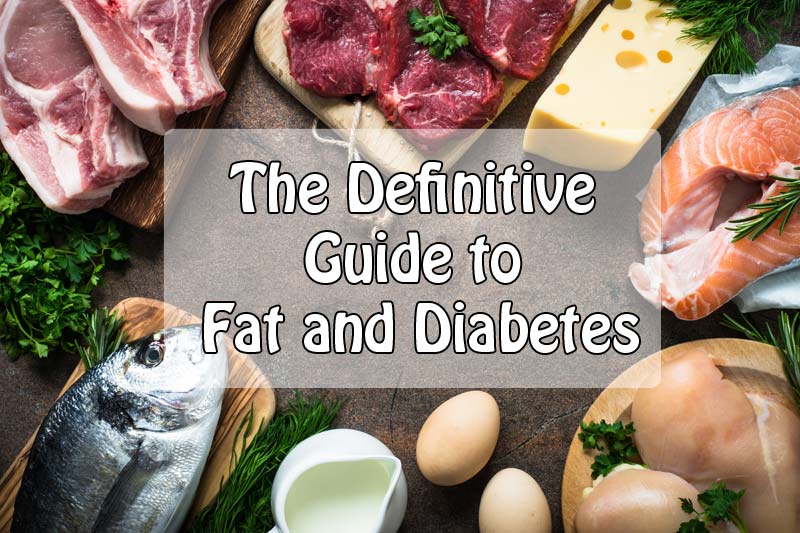
Before delving into this whole fat debate, think about fat for a moment…
When you think about fat from an evolutionary perspective, humans have been eating it for centuries – in the form of meats, eggs and dairy products – staple food products that provide high amounts of nutrients.
And for centuries people have been lean and the rate of disease was kept relatively low – at least in terms of “lifestyle” diseases. In fact, throughout history, chances of dying from hunger, viral diseases or unfortunate accidents would have been more likely.
On the other hand, it’s only been decades since people have been eating processed and packaged foods. And alongside that there has been a dramatic increase in all types of health conditions, dramatic!
But as consumers we keep eating this packaged food, while at the same time succumbing to societal “norms” to fear fat – all the while wondering why we’re getting fatter and sicker.
When there are widely accepted nutritional “norms” (such as avoid saturated fat, reduce your cholesterol intake because it raises your cholesterol, and eat low fat because fat will make you fat), we as consumers accept them as truth. After all, large health organizations are telling us to avoid it and they are there to protect the public. At least, that’s what we automatically assume.
But the truth really goes much deeper than this.
Instead of relying on outdated “norms” or myths, we’re here to explore the truth – based on scientific fact. This information is very, very long but is well worth reading to gain an in-depth understanding about fat and diabetes.
Of course, if you prefer to skip the details, click here to go straight to the end and read the conclusion.
Where the Big Fat Myth Began
When it comes to heart disease, there are some major misconceptions. These myths come out of research way back in the 1950s conducted by Ancel Keys.
Keys’ theory was that saturated fat promoted heart disease. And even though there was a lack of actual evidence, the “theory” was quickly picked up by the American Heart Association and the US Government and has been perpetuated ever since – despite much new (and better) evidence being available.
These myths have made their way around the world – UK, Canada, Australia, and even Asia. And a quarter of a century later, there are still no clinical trials that prove Keys’ “theory.”
Interestingly, around the same time as Keys’ research, there was another researcher, John Yudkin, who was arguing that sugar, not fat, was the driver of heart disease. But unfortunately, his message got swept under the carpet.
This myth about fat and heart disease has been to our detriment. We only have to look around to see that obesity, diabetes, heart disease, cancer and other health conditions have risen to MASSIVE proportions.
And now, not only are these conditions affecting older people as they once did. Now, children are suffering these diseases as well, which is just crazy (and very sad)!!
LDL “bad” cholesterol may be protective – if it’s the right size
When it comes to heart disease, cholesterol is often blamed as the victim. And of course, fat, particularly saturated fat, is blamed for raising cholesterol levels.
We know saturated fat intake does raise triglyceride levels and therefore, it can raise LDL cholesterol (the supposed “bad” stuff). But, looking at LDL alone is not the solution, as the sum total of LDL only has a very small association with heart disease.
Why?
Because there are different types of LDL particles – small dense LDL and large buoyant LDL.
The ones that are problematic are small dense LDL particles, with evidence showing they have a 3-fold risk of heart disease. Whereas large buoyant LDL may be protective.
The small dense LDL particles are the ones that cause havoc as they are susceptible to oxidation, they are proinflammatory (heart disease is initiated by inflammation), they are prothrombotic (cause clots), and these cause clogged and stiff arteries.
So you see, things can’t be “lumped” together into one category and given a “claim.” Call it conspiracy. Call it what you like. But the truth is, many of the nutritional “claims” we accept as “norms” are just big fat myths!
Another key fact, that is often overlooked, is that although the consumption of saturated fat does increase triglycerides and LDL, it also influences HDL (the “good” cholesterol), enhancing the metabolism of the good stuff.
Elizabeth has covered cholesterol in more detail over here – including additional tests you should request from your doctor.
Understanding fat
Fat is not inherently “bad.” In fact, we need it for many important processes in the body.
Fats are in all of our cell membranes aiding fat soluble substances like vitamins, hormones, and nutrients to easily transport in and out of cells – without fats, our body simply can’t function properly.
Fats are key elements in all the body’s tissues, including the brain. In fact, 60% of the solid weight of your brain is fat. Without fat your brain cannot function.
We also need fats for the production and formation of:
- Bile acids
- Sex hormones
- Adrenal hormones
- Vitamin D
- And cholesterol itself
Without fat or cholesterol in our body, we simply wouldn’t survive. Fat IS an essential nutrient.
There are four general categories of fats:
- Trans fat.
- Saturated fat.
- Polyunsaturated fat.
- Monounsaturated fat.
With fat, things tend to get “lumped” together into one category. For instance, the term “saturated fat” and “polyunsaturated fat.” But saturated fat is not a single kind of fat nor is polyunsaturated fat. We’ll be digging into that in more detail shortly.
One thing to note here though, is that all forms of fat contain ALL types of fats, also called “fatty acids” (with the exception of trans fats).
To demonstrate this, take a look at the following two charts.
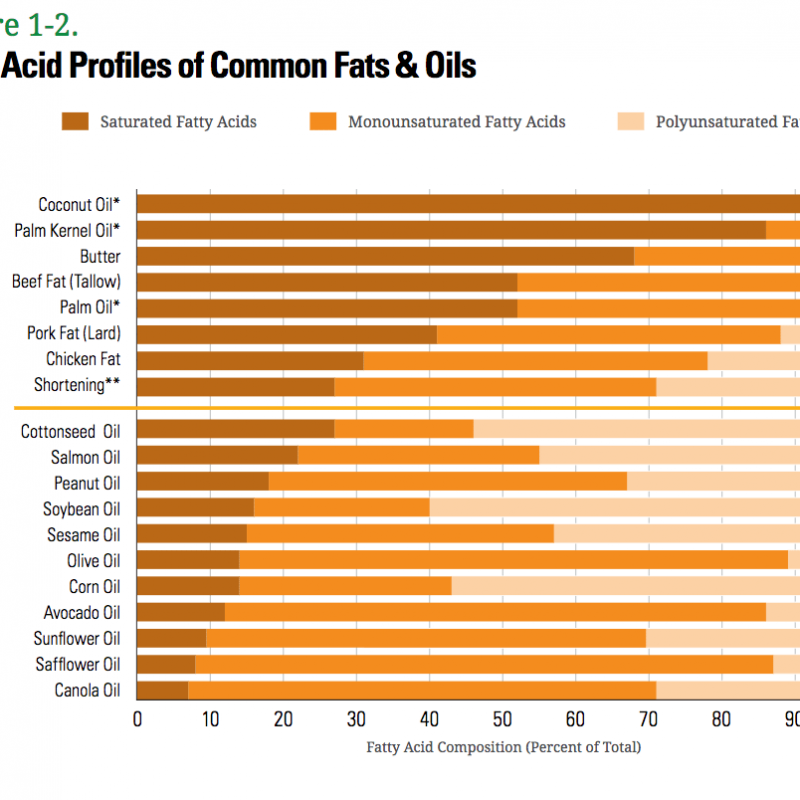
Image Courtesy: dietaryguidelines.gov
As you can see by this chart of oils, every oil contains all three types of fats to varying portions – saturated, linoleic (polyunsaturated, omega 6), alpha-linoleic acid (polyunsaturated, omega 3), oleic acid (monounsaturated, omega 9).
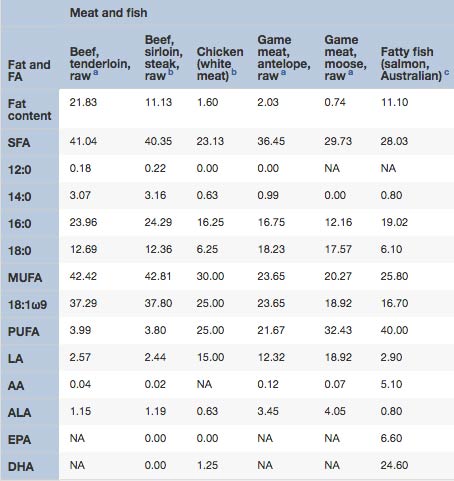
Image adapted from Journal of Nutritional Biochemistry
As you can see from the chart above, meats have a range of fats (fatty acids), too. Beef contains a higher amount of saturated fat (SFA) 41.04%, with a larger proportion of longer chain SFAs 16:0 and 18:0. While chicken is higher in monounsaturated fat (MUFA) 30% but also contains saturated fat 23.13%) and polyunsaturated fat (PUFA) 25% – it’s almost one-third of each.
These charts help demonstrate the diversity that fats really are. And since they come mixed like this directly from nature, it demonstrates that our body needs all of them to function.
So now let’s delve into each category of fats to get to know them better.
Trans fats
There are two types of trans fats:
- Naturally occurring (called ruminant trans fats) – found in meats and dairy
- Artificially produced – found in fast foods, bakery products and margarine
There is no debate about trans fats. Without a doubt, artificially produced trans fats are the enemy here – they are incredibly bad for our health.
When one observational study (2009) looked at replacing 2% of dietary fats in the diet with trans fats, risk of heart attack and death from heart disease increased by 20–30%.
Trans fats are formed in foods from the process of hydrogenation — think margarine, coffee creamers, microwave popcorn and other snack foods, frozen pizza, margarine, prepared desserts, and many other processed foods.
Basically, hydrogenation takes liquid vegetable oils such and turns them into solid oils. During this process artificial trans fats are created. Even trace amounts of artificial trans fats is harmful to our health and has been shown to increase risk of heart disease, period.
Ruminant trans fats do not cause the same problems. In fact, they contain conjugated linoleic acid, which has been associated with various health benefits for cancer, atherosclerosis (heart disease), growth, obesity, osteoporosis, and immune responses.
Saturated fat
As you saw in the meats chart above, there are different types of saturated fats. Basically these are made up of “chains” of fats from long chain saturated fatty acids to short and medium chain saturated fatty acids, 12:0, 14:0, 16:0 and 18:0.

In terms of nutrition, one of the biggest fears we have is to avoid saturated fat. But saturated fats in particular, are a source of energy, provide building blocks for structural elements in the body, assisting with protein modification, and they are needed for one of the body’s most important functions – regulating gene transcription.
While it’s easy to assume that the more saturated fat you eat the higher the saturated fat in your body will be. This isn’t entirely true. You see, your liver and fat tissue can produce saturated fat internally. And the fatty acids produced internally resemble those exact “chains” we talked about a moment ago.
And what may come as a surprise to you is that this process of internal fat production is driven by GLUCOSE intake (aka carbohydrates) – meaning the more carbs you eat, the more your body naturally synthesizes fatty acids.
Several studies show that saturated fat intake has no association with saturated fat content of the fat tissue in the body, which demonstrates that the body’s own production of fatty acids contributes largely to the saturated fat status in the body.
And did you get that last point – the more carbs you eat (not fat), the more your body naturally synthesizes fatty acids.
Unfortunately this process can be supercharged when you’re diabetic. As a diabetic, your body is in a state of metabolic crisis (metabolic syndrome) and you have insulin resistance. These mechanisms drive the conversion of carbohydrates to fatty acids at a higher rate – another good reason to cut down on carbs!
While it’s easy to assume that saturated fat is to blame for all our health problems, this is overly simplistic and inaccurate statement. Many food sources that contain saturated fats (meats, dairy and eggs) are very nutrient dense, containing high quality protein, along with vitamins and minerals our body needs. They are foods that come directly from nature, the way God intended.
If we’re going to get realistic here, the main sources of saturated fat in modern diets are NOT meat and dairy, they are things like pizza, pasta, sweets and dessert dishes that also contain trans fats, and omega 6 polyunsaturated fats. AND they often have high amounts of carbs as well – so they are basically a cocktail for fat production and inflammation (which promotes health problems).
The evidence for saturated fat and heart disease
Overall, studies have shown that when people reduce their saturated fat intake, there is little reduction in heart disease risk.
A large analysis of clinical trials (2015), which included a collective of 53,300 people, found some evidence that reducing saturated fat may minimally reduce risk of heart attack. But, there is no evidence it is linked to stroke.
In diabetics (who have a higher risk of heart disease already), there is no reduction in heart disease risk factors when eliminating fat. Even in patients who already have heart disease, there is no link between saturated fat intake and higher risk of heart attack, stroke or death.
The Multi-Ethnic Study of Atherosclerosis (2012) found that dairy intake, including full fat dairy, is not associated with increased heart disease risk. And in fact may reduce risk.
A large European study (2016) that included 35,597 participants found that dairy products lowered risk of ischemic heart disease, including butter, cheese, along with milk and milk products.
Another analysis (2015) looked at almost 27,000 people to see what dietary fat food sources might lead to increased rates of type 2 diabetes. What they found was that those consuming more high-fat dairy products, particularly cream, yogurt, and cheese, had a decreased risk of diabetes, while low-fat dairy showed an increased risk.
A review of observational studies (2013) found no association between high fat dairy and weight gain or obesity. And the conclusions around diabetes or heart disease risk were inconsistent and therefore, no conclusion could be made.
A meta-analysis of 21 studies (2010), which included a total of 347,747 subjects with a 5-23 year follow-up, found no significant evidence to conclude that saturated fat intake was associated with increased risk of heart disease.
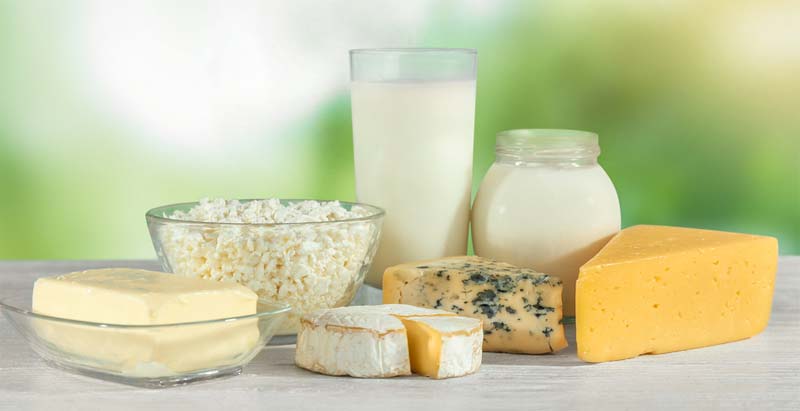
These are several recent studies so you no doubt get the picture, that in terms of heart disease, there has been no proven association between saturated fat intake – it is a myth!
In relation to type 2 diabetes, there is a bit more to this saturated fat story…
Saturated fat and insulin resistance
When insulin resistance is present there is a change in the body’s cell membranes – they become less flexible and fluid and this is one of the reasons that the function of insulin and the ability for glucose to transport across the cell is inhibited.
You see, fats make up the structure of our cell membranes. And what the research shows is that insulin resistance can be induced by saturated fat status in the body. What appears to be the case with insulin resistance is that the level of omega-3s and monounsaturated fats decrease and saturated fat increases.
While it’s easy to assume that eating saturated fat would lead to this dysfunction, this could actually occur for any number of reasons. As we’ve already covered above, the body can produce fatty acids internally, and one of the main drivers of this is carbohydrate intake.
So, if you’re eating a junk food, processed food diet, that is both high in sugar and fat, this could induce a whole range of metabolic changes, including insulin resistance.
In terms of insulin resistance though, research does seem to suggest a lower saturated fat intake is better. A higher intake of omega-3s and a lower intake of omega 6 is also beneficial, so that your ratio of omega 6/3 is kept in balance (more on that soon). And a higher intake of monounsaturated fat is also good.
In fact, a higher intake of omega-3s and monounsaturated fats has been shown to revert several metabolic abnormalities in the body (more on this soon too).
Saturated fat and inflammation
To complicate this even further, there’s the topic of inflammation.
Most lifestyle diseases, including type 2 diabetes, are diseases that are initiated by low-grade inflammation in the body’s cells.
Inflammation is a normal and natural process. Imagine when you cut yourself, the area swells, becomes red and generates heat. This is your body’s immune system sending in helper cells to heal the problem.
Now imagine your body being invaded by stimulants – sugar, refined carbohydrates, food additives, preservatives, chemicals, toxins, etc. The constant stimulus also promotes inflammation, the problem is, though your body tries to fight it, the stimulus doesn’t stop so as a result, low-grade inflammation spreads and cells begin to change in the way they function, organs begin to change in the way they function, and that’s when disease develops.
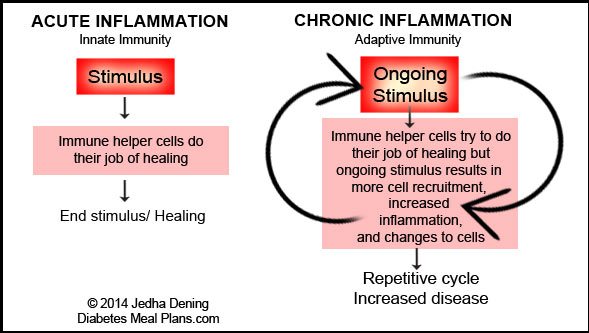
As a diabetic, your body is in a state of low-grade inflammation so you want to do everything to reverse that – calm down the body and get cells and organs functioning normal again.
People with a higher saturated fat status have been shown to have higher levels of inflammation in their bodies. But, remember, it’s not saturated fat intake that promotes higher saturated fat status. Your body can produce saturated fatty acids internally, namely from carbohydrates.
And there are other factors that influence inflammatory status too – lack of exercise, high dietary omega 6/3 ratio, chronic stress, anxiety and depression, air pollution (smoking included) and insufficient sleep.
While the science seems to suggest that saturated fats could potentially increase inflammation, it is an area that is really poorly understood, because there are so many factors involved.
So overall in terms of saturated fat and insulin resistance and inflammation, it is still a grey area.
So what’s the deal with saturated fat then?
Red meats
Red meats do contain more saturated fat than fish or poultry. But, red meat is very nutrient dense and contains many valuable nutrients your body needs, so it does not need to be eliminated.

In terms of research, there is some evidence to show that red meat intake may increase risk of disease. However, a big discretion must be made here – most studies do not separate fresh meat from processed meat and there is a big difference between the two.
In cases where there is separation, the common conclusion is that higher heart disease risk occurs with saturated fat intake from processed meat. We’re talking about things like bacon, ham, luncheon meats, deli meats and so forth.
Our recommendations: Follow the general dietary guidelines to consume lean sources of red meat most of the time. And don’t just eat red meat all the time. Change it up with chicken, turkey, pork, game meats, and especially fish, to ensure you consume a wider variety of fat sources.
Processed meats
In the low carb community, bacon is all the rage but we don’t promote bacon as a food to include in your diet on a regular basis – for obvious reasons.
Sure, on the odd occasion it’s fine. But bacon is a processed meat and all processed meats have been linked to higher risk of heart disease and health problems.
Our recommendation: Keep processed meats to a minimum.
Dairy products
According to the research, dairy products, including full fat varieties are safe to consume. Full fat varieties often contain less overall carbohydrates and sugar as well.
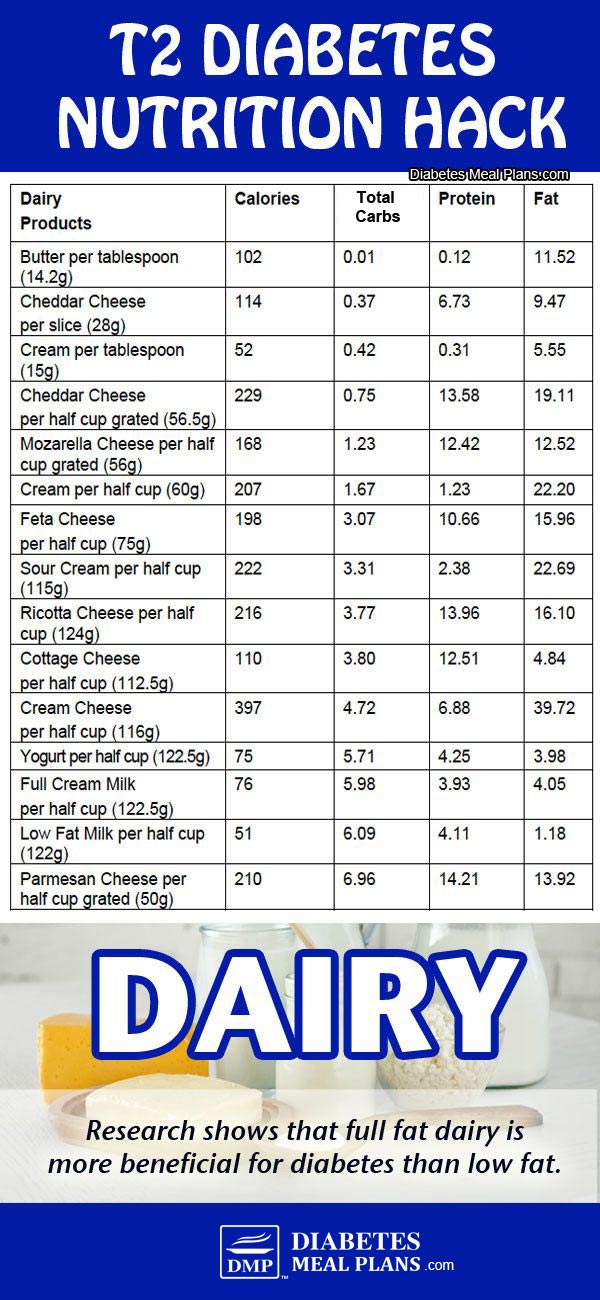
Coconut oil
In terms of oils, coconut oil, a medium chain fat has been shown to have many health benefits, so is safe to include in a healthy diet plan.
Packaged and processed foods
Dietary guidelines worldwide still suggest people should avoid saturated fat.
BUT take note: the list of saturated fat foods they include is generally a whole range of ‘convenience’ foods like potato chips, energy bars, biscuits, crackers, pastries, desserts, burgers and take away foods.
We agree, these foods are unhealthy and should be avoided.
Polyunsaturated fats
All polyunsaturated fats are “lumped” under that same old umbrella. And like saturated fats, this type of generic labeling is a BIG problem. Because there are two types of polyunsaturated fat, one is great for your health and the other is not so good.
The two types of polyunsaturated fats are:
- Omega 6 – proinflammatory
- Omega 3 – anti-inflammatory
We already talked about inflammation above and we know your goal as a diabetic is to reduce inflammation, not encourage it.
The ratio of omega 6/3 in the body is meant to be around 2:1 or a maximum of 4:1. Modern Western diets show levels as high as 20:1!
And there are many, many studies that show the high rate of omega 6 consumption is driving up chronic low-grade inflammation.
The simple solution is to give your body a polyunsaturated fat oil change…
Eat more omega 3-rich polyunsaturated fats:
- Flaxseed oil
- Walnut oil
- Macadamia nut oil
- Avocado oil
- Organic sunflower oil (high oleic)
- Sesame oil
- Nuts
- Chia seeds
- Flax seeds
- Hemp seeds
- Salmon
- Tuna
- Sardines
- Mackerel
- Anchovies
Don’t eat these omega 6 polyunsaturated fats:
- Margarine
- Rice bran oil
- Corn oil
- Vegetable oil
- Safflower oil
- Sunflower oil (except organic)
- Soybean oil
- Peanut oil
Please pin, tweet or share; then keep on reading.
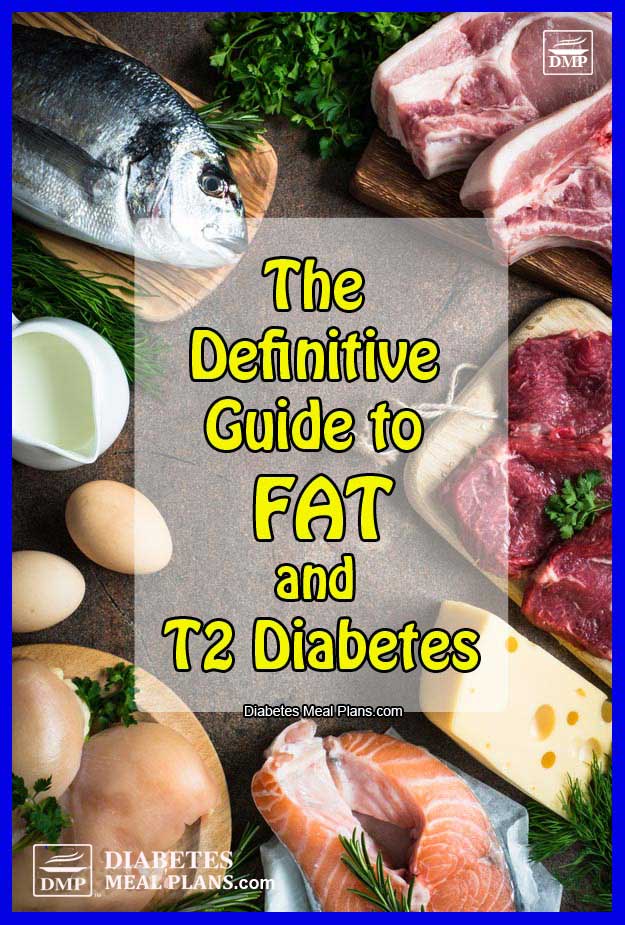
The evidence for polyunsaturated fats
A meta-analysis of 12 clinical trials (2014) showed that consuming an average of 56 grams of nuts per day improves A1c levels by an average 0.07% and lowers fasting glucose by an average 0.15 mg/dL. And in general, most studies agree that consumption of nuts improves cholesterol profiles.
Compared to intake of carbohydrates or saturated fat, replacing them with polyunsaturated fat appears to have the greatest effect on A1c, blood glucose and insulin levels. However, in terms of heart disease, replacing saturated fat in the diet with mostly omega 6 fats, has absolutely no benefits.
A meta-analysis (2009) of 23 clinical trials in individuals with type 2 diabetes, found that omega-3 fatty acid supplementation (average dose, 3.5 g/day) had effects on cholesterol levels, slightly lowering triglyceride levels and VLDL but raising LDL (by 1.9 mg/dL).
Though there have been mixed results for consumption of fish oil, the most common method of consuming omega 3s, overall the shown benefits for type 2 diabetics are great – lower triglycerides, improved elasticity of the arteries, greater maintenance of renal function, improved insulin sensitivity, reduced symptoms of diabetic neuropathy, and benefits for fatty liver.
Monounsaturated fats
Monounsaturated fats are the very best type of fat you can eat and offer many benefits to diabetics for reducing blood glucose, A1C, cholesterol, and inflammation.
And all nutritional experts will agree that monounsaturated fat is considered one of the most beneficial fats for cardiovascular health.
Canola oil is also a monounsaturated fat that often gets recommended but in most cases, it is a low quality, processed oil, so you are far better off to choose olive oil for cooking and eating purposes.
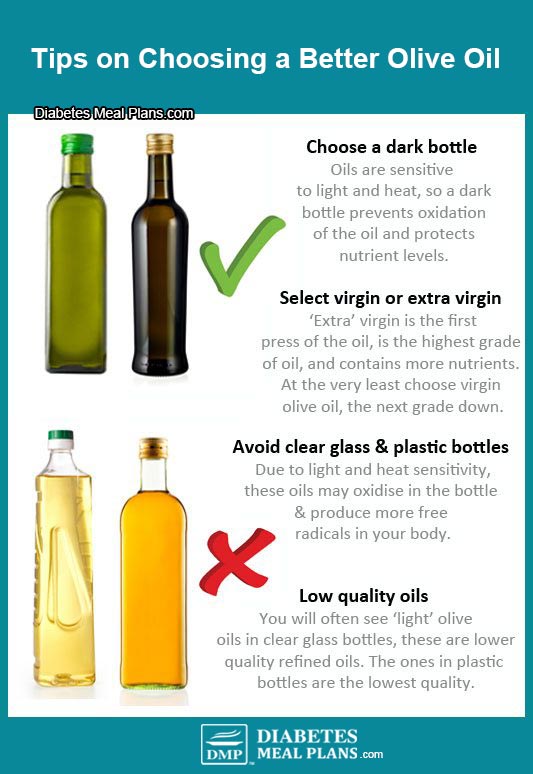
The evidence for monounsaturated fats
Research shows that monounsaturated fat (olive oil, olives, nuts and seeds, avocado) has massive benefits for type 2 diabetics – that’s why we recommend you use monounsaturated fats the most!
In the PREDIMED study, a diet consisting of 41% fat with the inclusion of approximately 4 tablespoons of olive oil or a handful of nuts each day, reduced risk of cardiovascular events by as much as 30% in high risk patients.
Olive oil offers 36 different polyphenols, one of which is oleocanthal, a known anti-inflammatory agent that works on the same pathways as NSAID ibuprofen.
In terms of heart disease, olive oil consumption has been shown to down regulate inflammatory genes implicated in atherosclerosis, change the status of oxidative stress, inflammation, lipid peroxidation, and lipid profile in coronary artery disease, and prevent a compound called trimethylamine N-oxide (TMAO) that has been linked to higher risk for atherosclerosis, heart attacks, heart failure, and strokes.
For type 2 diabetes specifically, olive oil consumption has been shown to protect against pancreatic beta-cell dysfunction, improve insulin resistance, protect against diabetic retinopathy (eye problems), improve glycemic control, enhance glucose transport into cells, reverse saturated fatty acid-induced insulin resistance (which we talked about earlier), assist in reducing A1c levels, and improve cholesterol.
A study (2017) in prediabetic patients showed that a diet enriched in monounsaturated fat helps decrease liver fat and increase insulin sensitivity.
A review (2016) evaluating the replacement of carbohydrates for monounsaturated fats shows that it produces significant reductions in fasting blood sugar levels, triglycerides, weight and blood pressure, along with increasing HDL (“good”) cholesterol. And when comparing polyunsaturated fats to monounsaturated, the poly’s did not produce these results.
We could go on and on with the research but you no doubt get the point, monounsaturated fats are the good guys here.
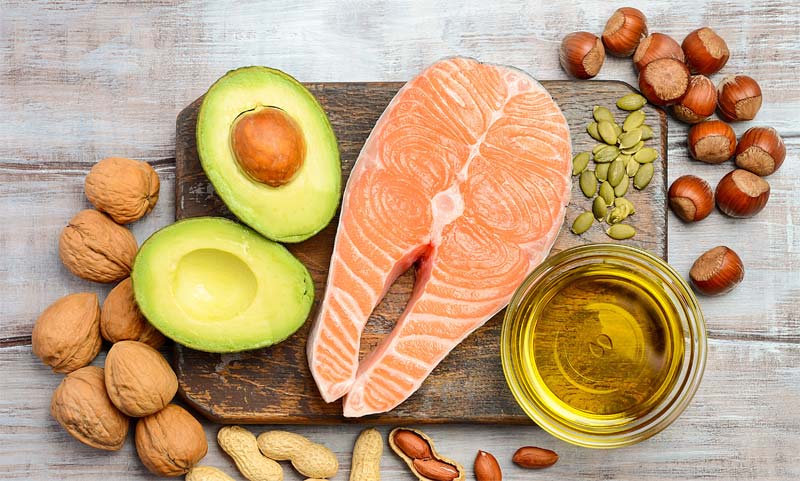
So what’s the conclusion about fat and diabetes?
Many of the things we think we “know” about fats are in actual fact, myths. There is no reason to fear fat because we need to eat all forms of fat for the body to function optimally.
Heart disease, along with other conditions are NOT just the result of fat intake but of suboptimal lifestyles that we choose to engage in, lifestyles we’re not naturally made for.
Some of these suboptimal ‘habits’ include excessive caloric intake, unbalanced unhealthy diet, physical inactivity, insufficient sleep, chronic stress, unhealthy environment (e.g. smoking) and abnormal gut bacteria (that is often altered by bad diet).
The high levels of cholesterol that people experience nowadays is influenced by these many lifestyle factors also. And collectively these factors cause low-grade inflammation, which initiates the development of heart disease.
As Dr. Aseem Malhotra, award-winning cardiologist emphasizes, the concept that saturated fat ‘clogs your pipes’ is simply wrong. Heart disease is an inflammatory condition and it’s the inflammation that also promotes cholesterol deposition, emerging kind of like a ‘pimple.’
The thing to recognize is in this whole fat debate is that there is a big difference between natural saturated fats found in unprocessed meats like lean beef, poultry, fish, eggs and dairy products, than the types found in crisps, margarine or packaged crackers and desserts.
Quite simply put, modern processing of foods changes their form and function for the body – in many cases altering metabolism.
One important thing to keep in mind is that out of all the macronutrients (carbs, protein, fat), fat is the nutrient that has the lowest impact on both blood sugar and A1c. Compared to carbohydrates and even protein, it does not cause blood sugar to rise and it does not promote insulin production – and that’s a good thing.
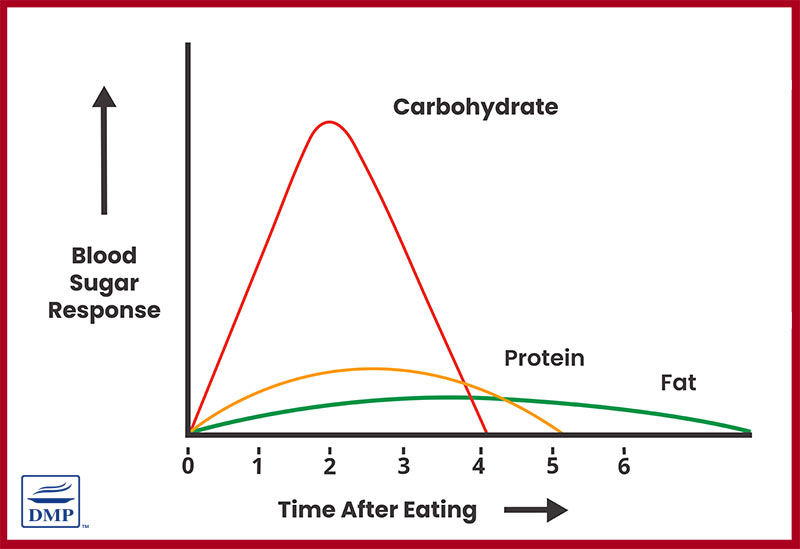
Here at Diabetes Meal Plans we encourage a low carb diet because science shows it produces the best outcomes for you. When you follow a low carb diet, it is natural to increase fat intake to make up some of your lost calories.
But, don’t do that by chowing down on bacon for your daily breakfast. Be smart. Avoid processed meats and packaged and processed foods.
Based on the evidence, you can safely eat coconut oil, butter, full fat or low fat dairy products, eggs, and all forms of natural meats (beef, lamb, chicken, turkey), though it is best to choose lean red meats.
Also include variety in your meal plans, aiming for at least two serves of fish each week, along with options like chicken, turkey, shrimp, pork and game meats.
Overall, monounsaturated fats and omega 3s are best to eat – olive oil, avocado, olives, macadamia nut oil, sesame oil, flaxseed oil, sunflower oil (occasionally), walnut oil, almonds, walnuts, macadamia nuts, salmon, tuna, sardines, chia seeds, hemp seeds, and other nuts and seeds.
And of course, base your low carb diabetic diet on large doses of non starchy vegetables. These should make up the bulk of your plate because they offer serious disease-fighting powers!
Please pin, tweet or share this important info around to help others. Thanks!

robert carnrike, BSHN
Thank you! I keep pushing The origional Atkin’s diet for people of all issues when they come see me in my practice. I appreciate that I am not the only one that Beleives in the low carb and high protien / fat diets but has to be modified to include the healthy carbs to include the proper fiber in the diet.
Malorie: Dietitian (MS, RD, CLT)
Yes, adequate fiber with while reducing carb intake is definitely important!
steph
Brilliant, informative post – thank you so much!
Pascual
Hello
I am a nutritionist, I write to you from Spain.
What do you think of the use of products rich in CLA or nutritional supplements to improve blood sugar levels.
Thank you
Jedha
Hi Pascual! Foods that contain CLA are all nutrient-dense whole food sources such as dairy, poultry, beef, eggs etc, so they certainly fit into a healthy diet. As for nutritional supplements they can certainly help too. Some with known benefits include cinnamon, berberine, fish oil, alpha lipoic acid, magnesium, among others.
josehine
Once again thank you for your excellent information . God bless and reward you and your team . l now understand a whole lot of myths in relation to our diet. what do we use as creamer on our coffee? Josephine
Jedha
Milk or cream is still okay Josephine.
jim
Another excellent job done by Jedha! Near the beginning of the conclusion section is a link to gut health, another excellent job done by Elizabeth! I’m 71 years old and have been over weight for 60 of those 70 years. This puts me right at the prime time for so much of the incorrect direction for inappropriate eating. My current physician is close to my age and isn’t helping to correct what I see as the errors of the last 6 decades.
1. If I went to I younger Dr. would I be more apt to hear more modern thinking?
2. How long do you think it could take to correct the errors of the past 50 years?
3. Is there hope that my grandchildren have a chance of avoiding such problems?
Jedha
Thanks for your kind words Jim – it’s all in the aim to help YOU, so we hope it does. :)
In answer to your questions:
1) It depends, crazily enough, many young physicians are still being taught outdated information as well. But, there are physicians who are more current. You really need to “shop” around, so to speak. Physicians work for you so find someone who is progressive and stays abreast of current research.
2) How long is a piece of string! It depends WHAT you do. BUT, the human body has an AMAZING capacity to heal. So, every single step you take has benefits. And every single thing you do has cumulative results.
3) Yes, if they are educated. But chances are they may not be educated by schools, physicians or other people surrounding them. So, that means YOU can educate them. Children learn via influence and modelling. The best we can do as parents or grandparents is provide them with health information and encourage things like healthy food and exercise. Skip sweets as rewards and use activities instead. And one skill every child should learn is cooking – maybe you can have a cooking day or hour when you see them – that is invaluable!!
Carlos
Hello
My father is type 2 diabetic
I will send the link of your web
I think i could help you